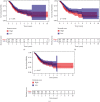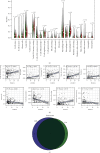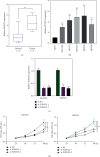The Upregulation of PLXDC2 Correlates with Immune Microenvironment Characteristics and Predicts Prognosis in Gastric Cancer
- PMID: 34777633
- PMCID: PMC8589478
- DOI: 10.1155/2021/5669635
The Upregulation of PLXDC2 Correlates with Immune Microenvironment Characteristics and Predicts Prognosis in Gastric Cancer
Abstract
Tumor microenvironment (TME) has been demonstrated to exhibit a regulatory effect on the progressions of gastric cancer (GC). However, the related functions of stromal and immune components (TME-associated genes) in TME remain largely unclear. From the TCGA dataset, we downloaded the clinical data of 375 GC cases and then estimated the percentage of tumor-infiltrating immunocytes (TICs) and the levels of immune and stromal constituents by the use of CIBERSORT and ESTIMATE tolls. Univariate assays were applied to study the differentially expressed genes. The associations between the clinical information of GC patients and the expressions of the specific genes were analyzed based on the TCGA datasets. The effect of Plexin domain containing 2 (PLXDC2) expression on TICs was conducted. We observed that PLXDC2 expression was distinctly upregulated in GC specimens compared with nontumor gastric specimens. Its upregulation was associated with advanced clinical stages and predicted a shorter overall survival of GC patients. The genes in the group of higher expressing PLXDC2 were primarily enriched in immunity-associated events. By the use of CIBERSORT, we observed that PLXDC2 expressions were related to the proportion of dendritic cells resting, T cell CD4 memory resting, eosinophils, mastocyte resting, mononuclear cells, plasma cells, T cell follicle helper, macrophage M2, and dendritic cells activated. Overall, our discoveries revealed that the expression of PLXDC2 was remarkable in GC, might be a possible biomarker for GC, and provided novel contents regarding immune infiltrates, offering novel insight for treatments of GC.
Copyright © 2021 Yang Li et al.
Conflict of interest statement
The authors declare that they have no competing interests.
Figures









Similar articles
-
Identification of pivotal genes associated with the prognosis of gastric carcinoma through integrated analysis.Biosci Rep. 2021 Apr 30;41(4):BSR20203676. doi: 10.1042/BSR20203676. Biosci Rep. 2021. PMID: 33754626 Free PMC article.
-
Overexpression of PLXDC2 in Stromal Cell-Associated M2 Macrophages Is Related to EMT and the Progression of Gastric Cancer.Front Cell Dev Biol. 2021 May 28;9:673295. doi: 10.3389/fcell.2021.673295. eCollection 2021. Front Cell Dev Biol. 2021. PMID: 34124056 Free PMC article.
-
BICC1 as a novel prognostic biomarker in gastric cancer correlating with immune infiltrates.Int Immunopharmacol. 2020 Oct;87:106828. doi: 10.1016/j.intimp.2020.106828. Epub 2020 Jul 28. Int Immunopharmacol. 2020. PMID: 32736193
-
Dysregulation of non-coding RNAs in gastric cancer.World J Gastroenterol. 2015 Oct 21;21(39):10956-81. doi: 10.3748/wjg.v21.i39.10956. World J Gastroenterol. 2015. PMID: 26494954 Free PMC article. Review.
-
Molecular Mechanism for Malignant Progression of Gastric Cancer Within the Tumor Microenvironment.Int J Mol Sci. 2024 Oct 31;25(21):11735. doi: 10.3390/ijms252111735. Int J Mol Sci. 2024. PMID: 39519285 Free PMC article. Review.
Cited by
-
Adaptive c-Met-PLXDC2 Signaling Axis Mediates Cancer Stem Cell Plasticity to Confer Radioresistance-associated Aggressiveness in Head and Neck Cancer.Cancer Res Commun. 2023 Apr 19;3(4):659-671. doi: 10.1158/2767-9764.CRC-22-0289. eCollection 2023 Apr. Cancer Res Commun. 2023. PMID: 37089864 Free PMC article.
-
Prognostic significance of JAM 3 in gastric cancer: An observational study from TCGA and GEO.Medicine (Baltimore). 2023 Apr 25;102(17):e33603. doi: 10.1097/MD.0000000000033603. Medicine (Baltimore). 2023. PMID: 37115068 Free PMC article.
-
Cancer Stem Cells and the Tumor Microenvironment in Gastric Cancer.Front Oncol. 2022 Jan 3;11:803974. doi: 10.3389/fonc.2021.803974. eCollection 2021. Front Oncol. 2022. PMID: 35047411 Free PMC article. Review.
-
Comprehensive analysis and validation reveal DEPDC1 as a potential diagnostic biomarker associated with tumor immunity in non-small-cell lung cancer.PLoS One. 2024 Apr 2;19(4):e0294227. doi: 10.1371/journal.pone.0294227. eCollection 2024. PLoS One. 2024. PMID: 38564630 Free PMC article.
References
MeSH terms
Substances
LinkOut - more resources
Full Text Sources
Medical
Molecular Biology Databases
Research Materials
Miscellaneous

